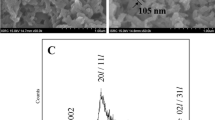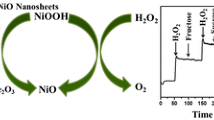Abstract
We are presenting a sensor for hydrogen peroxide (H2O2) that is based on the use of a heterostructure composed of Pt nanoparticles (NPs) and carbon nanofibers (CNFs). High-density Pt NPs were homogeneously loaded onto a three-dimensional nanostructured CNF matrix and then deposited in a glassy carbon electrode (GCE). The resulting sensor synergizes the advantages of the conducting CNFs and the nanoparticle catalyst. The porous structure of the CNFs also favor the high-density immobilization of the NPs and the diffusion of water-soluble molecules, and thus assists the rapid catalytic oxidation of H2O2. If operated at a working voltage of −0.2 V (vs. Ag/AgCl), the modified GCE exhibits a linear response to H2O2 in the 5 μM to 15 mM concentration range (total analytical range: 5 μM to 100 mM), with a detection limit of 1.7 μM (at a signal-to-noise ratio of 3). The modified GCE is not interfered by species such as uric acid and glucose. Its good stability, high selectivity and good reproducibility make this electrode a valuable tool for inexpensive amperometric sensing of H2O2.

The Pt NPs/CNF heterostructure-based H2O2 sensor synergizes the advantages of both the conducting carbon nanofibers and the nanoparticle catalyst. The 3D structure of the nanofibers favor high density immobilization of the nanoparticles and penetration by water-soluble molecules, which assists the catalyic oxidation of H2O2. The sensor shows outstanding performance in terms of detection range, detection limit, response time, stability and selectivity.







Similar content being viewed by others
References
Zhai MM, Cui RJ, Gu N, Zhang GH, Lin W, Yu LJ (2015) Nanocomposite of Au nanoparticles/helical carbon nanofibers and application in hydrogen peroxide biosensor. J Nanosci Nanotechnol 15:4682–4687
Zhang JX, Tu LP, Zhao S, Liu GH, Wang YY, Wang Y, Yue Z (2015) Fluorescent gold nanoclusters based photoelectrochemical sensors for detection of H2O2 and glucose. Biosens Bioelectron 67:296–302
Liu JL, Lu LL, Li AQ, Tang J, Wang SG, Xu SY, Wang LY (2015) Simultaneous detection of hydrogen peroxide and glucose in human serum with upconversion luminescence. Biosens Bioelectron 68:204–209
Dong S, Xi JB, Wu YN, Liu HW, Fu CY, Liu HF, Xiao F (2015) High loading MnO2 nanowires on graphene paper: facile electrochemical synthesis and use as flexible electrode for tracking hydrogen peroxide secretion in live cells. Anal Chim Acta 853:200–206
Wang JJ, Han DX, Wang XH, Qi B, Zhao MS (2012) Polyoxometalates as peroxidase mimetics and their applications in H2O2 and glucose detection. Biosens Bioelectron 36:18–21
Abo M, Urano Y, Hanaoka K, Terai T, Komatsu T, Nagano T (2011) Development of a highly sensitive fluorescence probe for hydrogen peroxide. J Am Chem Soc 133:10629–10637
Anwar N, Vagin M, Laffir F, Armstrong G, Dickinson C, McCormac T (2012) Transition metal ion-substituted polyoxometalates entrapped in polypyrrole as an electrochemical sensor for hydrogen peroxide. Analyst 137:624–630
Xiang Y, Lu Y (2011) Using personal glucose meters and functional DNA sensors to quantify a variety of analytical targets. Nat Chem 3:697–703
Jia LP, Wang HS (2013) Preparation and application of a highly sensitive nonenzymatic ethanol sensor based on nickel nanoparticles/Nafion/graphene composite film. Sensors Actuators B Chem 177:1035–1042
Wang BJ, Gu SQ, Ding YP, Chu YL, Zhang Z, Ba X, Zhang QL, Li XR (2013) A novel route to prepare LaNiO3 perovskite-type oxide nanofibers by electrospinning for glucose and hydrogen peroxide sensing. Analyst 138:362–367
Jin YD (2012) Engineering plasmonic gold nanostructures and metamaterials for biosensing and nanomedicine. Adv Mater 24:5153–5165
Wang YQ, Yan B, Chen LX (2013) SERS Tags: Novel optical nanoprobes for bioanalysis. Chem Rev 113:1391–1428
Zhu H, Du ML, Zhang M, Zou ML, Yang TT, Wang LN, Yao JM, Guo BC (2014) Probing the unexpected behavior of AuNPs migrating through nanofibers: a new strategy for the fabrication of carbon nanofiber–noble metal nanocrystal hybrid nanostructures. J Mater Chem 2:11728–11741
Zhang P, Zhang X, Zhang S, Lu X, Li Q, Su Z, Wei G (2013) One-Pot green synthesis, characterizations, and biosensor application of self-assembled reduced graphene oxide-gold nanoparticle hybrid membranes. J Mater Chem B 1:6525–6531
Bai H, Han M, Du Y, Bao J, Dai Z (2010) Facile synthesis of porous tubular palladium nanostructures and their application in a nonenzymatic glucose sensor. Chem Commun 46:1739–1741
Wang G, Lu X, Zhai T, Ling Y, Wang H, Tong Y, Li Y (2012) Free-standing nickel oxide nanoflake arrays: synthesis and application for highly sensitive non-enzymatic glucose sensors. Nanoscale 4:3123–3127
Zhang PP, Zhao XN, Zhang X, Lai Y, Wang XT, Li JF, Wei G, Su ZQ (2014) Electrospun doping of carbon nanotubes and platinum nanoparticles into the β‑phase polyvinylidene difluoride nanofibrous membrane for biosensor and catalysis applications. ACS Appl Mater Interfaces 6:7563–7571
Li MJ, Zhang JH, Zhang H, Liu YF, Wang CL, Xu X, Tang Y, Yang B (2007) Electrospinning: a facile method to disperse fluorescent quantum dots in nanofibers without Forster resonance energy transfer. Adv Funct Mater 17:3650–3656
Lu XF, Wang C, Wei Y (2009) One-dimensional composite nanomaterials: synthesis by electrospinning and their applications. Small 5:2349–2370
Wang G, Xu JJ, Chen HY, Lu ZH (2003) Amperometric hydrogen peroxide biosensor with sol-gel/chitosan network-like film as immobilization matrix. Biosens Bioelectron 18:335–343
Zheng JS, Wang XZ, Fu R, Yang DJ, Li P, Lv H, Ma JX (2012) Microstructure effect of carbon nanofibers on Pt/CNFs electrocatalyst for oxygen reduction. Int J Hydrog Energy 37:4639–4647
Park SM, Jung DH, Kim SK, Lim S, Peck D, Hong WH (2009) The effect of vapor-grown carbon fiber as an additive to the catalyst layer on the performance of a direct methanol fuel cell. Electrochim Acta 54:3066–3072
Kang S, Lim S, Peck DH, Kim SK, Jung DH, Hong SH, Jung HG, Shul Y (2012) Stability and durability of PtRu catalysts supported on carbon nanofibers for direct methanol fuel cells. Int J Hydrog Energy 37:4685–4693
Shu J, Ma R, Shui M, Wang Y, Long NB, Wang DJ, Ren YL, Zhang RF, Zheng WD, Gao S (2012) Facile fabrication of conducting hollow carbon nanofibers/Si composites for copper phthalocyanine-based field effect transistors and high performance lithium-ion batteries. RSC Adv 2:8323–8331
He F, Hu ZB, Liu KY, Zhang SR, Liu HT, Sang SB (2014) In situ fabrication of nickel aluminum-layered double hydroxide nanosheets/hollow carbon nanofibers composite as a novel electrode material for supercapacitors. J Power Sources 267:188–196
Yang Y, Fu RZ, Wang HY, Wang C (2013) Carbon nanofibers decorated with platinum nanoparticles:a novel three-dimensional platform for non-enzymatic sensing of hydrogen peroxide. Microchim Acta 180:1249–1255
Wang ZG, Xu ZK, Wan LS (2006) Modulation the morphologies and performance of polyacrylonitrile-based asymmetric membranes containing reactive groups: effect of non-solvents in the dope solution. J Membr Sci 278:447–456
Che AF, Huang XJ, Wang ZG, Xu ZK (2008) Preparation and surface modification of poly(acrylonitrile-co-acrylic acid) electrospun nanofibrous membranes. Aust J Chem 61:446–454
Chen LP, Hong SG, Zhou XP, Zhou ZP, Hou HQ (2008) Novel Pd-carrying composite carbon nanofibers based on polyacrylonitrile as a catalyst for Sonogashira coupling reaction. Catal Commun 9:2221–2225
An GH, Ahn HJ (2013) Pt electrocatalyst-loaded carbon nanofibre-Ru core-shell supports for improved methanol electro oxidation. J Electroanal Chem 707:74–77
Zhai DY, Liu BR, Shi Y, Pan LJ, Wang YQ, Li WB, Zhang R, Yu GH (2013) Highly sensitive glucose sensor based on Pt nanoparticle/polyaniline hydrogel heterostructures. ACS Nano 7:3540–3546
Wu MY, Wang QY, Li KN, Wu YQ, Liu HQ (2012) Optimization of stabilization conditions for electrospun polyacrylonitrile nanofibers. Polym Degrad Stab 97:1511–1519
Acknowledgments
The work has been supported by the National Natural Science Foundation of China (No. 51203013, 21302013), the Natural Science Foundation of Jiangsu Educational Department of China (No. 12KJB610001), the Natural Science Foundation of Jiangsu Province (No. BK2012207), and the Foundation of Jiangsu Laboratory of Advanced Functional Material (No. 12KFJJ008).
Author information
Authors and Affiliations
Corresponding authors
Electronic supplementary material
Below is the link to the electronic supplementary material.
ESM 1
(DOC 1790 kb)
Rights and permissions
About this article
Cite this article
Yang, Y., Fu, R., Yuan, J. et al. Highly sensitive hydrogen peroxide sensor based on a glassy carbon electrode modified with platinum nanoparticles on carbon nanofiber heterostructures. Microchim Acta 182, 2241–2249 (2015). https://doi.org/10.1007/s00604-015-1558-9
Received:
Accepted:
Published:
Issue Date:
DOI: https://doi.org/10.1007/s00604-015-1558-9




